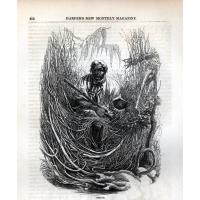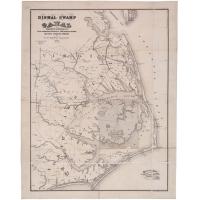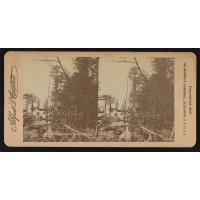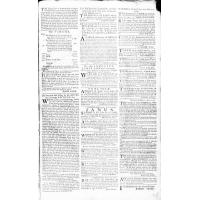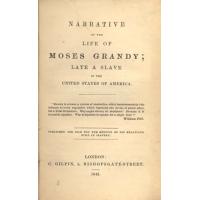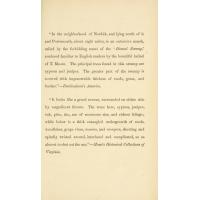The Great Dismal Swamp stretches from southern Virginia into northern North Carolina. In Virginia, it’s part of the 113,000-acre Great Dismal Swamp National Wildlife Refuge. In North Carolina, it’s set in the 14,000-acre Dismal Swamp State Park. Once covering more than one million acres (more than 1500 square miles), it was initially inhabited by Native peoples of the Chesapeake. The wetlands were later inhabited by men, women, and children escaping enslavement from approximately 1700 through the mid-19th century. Research suggests that these communities in the Dismal Swamp began to disperse around the time of the Civil War. While certainly noted as a place of African American anti-slavery resistance, there are some historians who also believe the Dismal Swamp communities were part of the larger Underground Railroad network.
When large groups of enslaved people escaped to geographically secluded regions to form communities, they were referred to as maroon communities. Despite the harsh conditions they lived in, they attempted to live as free people beyond the sight and control of enslavers or government officials. Historians generally agree that the largest maroon colony in the United States was in the Great Dismal Swamp, though maroon settlements formed in other colonies as well. Experts believe that anywhere slavery existed, there were people who escaped to live in the wilderness.
This album provides resources for learning more about the geography and history of the Dismal Swamp.
Ideas for Instruction:
- Begin with the QFT using the image of the plaque at Lake Drummond in the Great Dismal Swamp as the Q-Focus.
- After students have generated and ranked questions regarding the short passage, have them complete a Gallery Walk using the Notice and Wonder strategy.
- Use the following works:
- "The Lake of the Dismal Swamp" by John Gadsby Chapman, 1842
- "Osman, a maroon in Great Dismal Swamp" by David Hunter Strother in Harper's New Monthly Magazine, 1856
- ONE OF THESE: "Slave Hunt, Dismal Swamp, Virginia" by Thomas Moran, 1862 OR "Slave Hunt" by Thomas Moran, 1864
- "In the Swamp" by Henry Louis Stephens, c. 1863
- "Fugitive Slaves in the Dismal Swamp, Virginia" by David Edward Cronin, 1888
- "George Washington at Lake Drummond, Dismal Swamp," by Thos. Addis Emmet 1896
- At each piece, students will begin by writing only what they notice. After having an opportunity to view all the resources, students will then complete the wonder portion, revisiting each piece.
- Debrief the pieces and make connections to the Q-Focus and questions generated.
- Use these images to discuss primary and secondary sources. Which ones would students consider to be primary sources and why?
- Use the following works:
- Conduct a Jigsaw Activity to learn more about the geography and history of the Dismal Swamp.
- Use the following pieces:
- Description of the Dismal Swamp and a proposal to drain the swamp by William Byrd, c. 1728-1737
- Narrative of the Life of Moses Grandy: Late a Slave in the United States of America, 1843
- Slaves in The Dismal Swamp, The North Star. (Rochester, NY) 31 Mar. 1848
- Report on the Dismal Swamp in The Daily Spy. [volume] (Worcester [Mass.]), 10 July 1848
- The Virginia Maroons by Edmund Jackson, National Anti-Slavery Standard, February 12, 1852
- Provide students with a copy of the Primary Source Analysis Tool.
- Use prompts from the Teacher's Guide for Analyzing Books & Other Printed Texts and Teacher's Guide Analyzing Newspapers.
- Once back in their base groups, students will share the primary sources they explored and answer the following questions:
- What are the common themes among these sources?
- Do any of them answer the questions developed during the QFT?
- What claims can you make about the Dismal Swamp? What evidence do you have for your claims?
- Use the following pieces:
- Complete a comparative analysis of different maps of the area.
- Use the following maps:
- A map of the most inhabited part of Virginia containing the whole province of Maryland with part of Pensilvania, New Jersey and North Carolina, 1755 (Focus on the Tidewater and Piedmont regions.)
- Map of the Great Dismal Swamp by Martin Sanders, 2016
- Use Zoom-In to focus on small sections of each map before looking at them more broadly.
- Provide students with a copy of the Primary Source Analysis Tool.
- Use prompts from the Teacher's Guide Analyzing Maps.
- Use the following maps:
- Consider pairing your study of the history of the Dismal Swamp and the enslaved communities that lived there with a piece of historical fiction. In this album you will find links to Unbound by Ann E. Burg (2016) and Freewater by Amina Luqman Dawson (2022).
- For STEM connections, consider building a simple stereoscope to allow students to see sterograph images of the Dismal Swamp and Lake Drummond in 3D.
- Other resources in the ablum include poems and sheet music that provide additional perspectives on how the Dismal Swamp was viewed in popular culture.
- If you want to examine the development of the maroon community, the Digital Library on American Slavery has a series of runaway slave notices that all refer to the Dismal Swamp. These notices can be connected to the Advertisement by John Mayo in the Virginia Gazette, April 13, 1769.
3 - 5 6 - 8 Social Studies/History Virginia History Great Dismal Swamp Maroons African American History Geography North Carolina History
Replies displayed by creation date
 Tricia Stohr-Hunt, this is a fascinating topic that is and example of both "hard history" and "hidden history"! Your choice of sources from different archives enriches the inquiry. I was drawn to the painting by David Edward Cronin and the explanation given in the documentation as to when this 1888 painting of life in the Great Dismal Swamp during the 1860s would be a primary source.
Tricia Stohr-Hunt, this is a fascinating topic that is and example of both "hard history" and "hidden history"! Your choice of sources from different archives enriches the inquiry. I was drawn to the painting by David Edward Cronin and the explanation given in the documentation as to when this 1888 painting of life in the Great Dismal Swamp during the 1860s would be a primary source.
I am eager to see what sources you add and how you will engage students in this inquiry. On a personal note, I graduated from Hermitage High School in Richmond, Virginia, many years ago. The Great Dismal Swamp was not mentioned in my text-book-centric U.S. History class. It is so important to add this and other untold stories!
Thank you, Ann. My class read Freewater by Amina Luqman-Dawson this year, a novel based on the history of maroon communities in the South. This book provides opportunities for students to learn about the history of The Great Dismal Swamp. I'm hoping to add resources to help students understand more about the landscape and the history of this place.
Impressive! I'm going to read this book! Your plan to add resources about the landscape and the history of the Great Dismal Swamp is noteworthy. The best route to find these at LOC.gov is to submit a question to ASK A Librarian in the Georgraphy and Maps Division. They will get back to you in 5 working days which is in time for this project. https://ask.loc.gov/map-geography
Thanks, Ann. I will reach out to them.
In working on this album, I would like to connect to Freewater and the book Unbound by Ann E. Burg, which is a verse novel that tells the story of a young enslaved girl and her family who escape and join a maroon community in the Great Dismal Swamp. I'm not sure how to structure that yet. I am learning a lot about creating and editing this album, so I'm happy about that.
Tricia, this website is sponsored by a different federal government agency, the Federal Wildlife Refuge, but certainly one in which the primary sources are authoritative and authentic. You may use any of these maps or images in your album and pair them with the fiction book you have discovered written about this location.
Such a wonderful mix of formats; it is often difficult to find maps, newspapers, manuscripts, photos, prints AND sheet music on a topic! Nice job  Tricia Stohr-Hunt
. At some point, would you consider posting a link to this album in the Maps and Geography Group? I've made a note to self to check out Freewater by Amina Luqman-Dawson.
Tricia Stohr-Hunt
. At some point, would you consider posting a link to this album in the Maps and Geography Group? I've made a note to self to check out Freewater by Amina Luqman-Dawson.
Thanks, Sherrie. I will look at adding this to the Maps and Geography group. I appreciate you mentioning it.
This is a wonderful album! You have found some true gems to share with your students. Here are a couple of links that may help in crafting the background knowledge base, especially if you are creating educator PD.
With all of the so-called maroon communities, environment was crucial. The escaped enslaved headed to places that were challenging to access, Ft. Mose in Florida, the Great Dismal Swamp, etc. Ecologies of Black Freedom: Knowledge and Resistance You can download this short paper.
The is a really good book on the topic. There are probably passages that would be appropriate for middle and high school students. Armed in the Great Swamp: Fear, Maroon Insurrection, and the Insurgent Ecology of the Great Dismal Swamp.
The Virginia Historical Society has quite a few videos and other resources.
There are a number of archaeological investigations of the communities in the GDS also. Artifacts can really spark inquiry with students. Deep in the Swamps, Archaeologists Are Finding How Fugitive Slaves Kept Their Freedom.
Conservation of the GDS is a hot topic. There is an effort to have it declared a National Monument not just a Wildlife Area or a State Park. The Wilderness Society is very involved. Great Dismal Swamp, an Irreplaceable Hub of Black and Indigenous History.
Michelle,
Thank you for so many wonderful suggestions. I used the Smithsonian article with my class this spring.
I have two nonfiction books about maroons in the GDS, but have not seen the title you mention. I will definitely look for it.
 Tricia Stohr-Hunt, you have a wonderful variety in primary source formats with sheet music, images, manuscripts and maps in your album. This is an excellent primary source set to share with classroom teachers. One question they may have is, how can these different types of primary and secondary sources best support student driven inquiry and research about Freedom in the Great Swamp. Which inquiry strategies would you recommend for the maps or images or manuscripts that you have included in this album.
Tricia Stohr-Hunt, you have a wonderful variety in primary source formats with sheet music, images, manuscripts and maps in your album. This is an excellent primary source set to share with classroom teachers. One question they may have is, how can these different types of primary and secondary sources best support student driven inquiry and research about Freedom in the Great Swamp. Which inquiry strategies would you recommend for the maps or images or manuscripts that you have included in this album.
Tricia,
I'm not sure how well this collection fits with your ultimate goal, but the Library as a page devoted to the Stono Rebellion found here: https://www.loc.gov/item/today-in-history/september-09/
Tricia, so sorry about getting disconnected earlier today. I wanted to tell you that I love your album theme and you found such a wonderful variety of resources. I will go back through it and add other comments that come to mind.
Thanks, Amy. I will do the same with yours.
Tricia,
Again, I just love the interesting resources you found for this topic. The variety will definitely be engaging for students. The sheet music is an interesting find! It is always amazing to me how people build community in the most difficult of places.
I think the lesson you've built around this topic is fantastic. Even though your lesson is for older students, I came across this Blue Ridge Parkway Foundation pamphlet for kids about the ecosystem of the Great Dismal Swamp. https://www.kidsinparks.com/great-dismal-swamp-national-wildlife-refuge. It comes at the topic from a different perspective in a simplified format, but might be a good modern contrast to the other illustrations from the LOC collection.
Thanks, Amy! This is terrific. I appreciate you taking the time to review my album.
Excellent! I just posted a discussion about Maroonage in Four Holes Swamp in South Carolina and someone referenced your post. Thank you for all the additional resources.
Testimonials
- I love that there is new info on the site daily!
- I had a wonderful time working with the Library of Congress and learning about all of the resources at my fingertips!
- The TPS Teachers Network has an equal exchange of ideas. You know it's not a place where you're being judged.
- My colleagues post incredibly fine resources and ideas....the caliber of the suggestions and resources make me feel that I take a lot from it. It's a takeaway. And I hope that I can give back as much as I get.
- Going into this school year, I have a fantastic new resource for my own instruction and to share with my colleagues!
- I am very glad that I discovered the TPS Teachers Network through RQI. Great resources can be hard to find out there on the internet!





